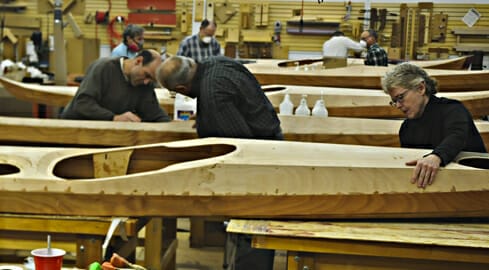Building A Kayak

Building A Kayak

Okay, so you’ve decided to build your own kayak. But hold on a minute. Building a kayak involves a lot more than a few weekends out in the garage sanding plywood or doping canvas panels.
Building a kayak is a considerable investment–in tools, materials, space, and most of all, time. Now don’t get me wrong–building your own boat can be a wonderful and rewarding experience.
Nothing beats the pride you’ll feel when someone compliments you on your creation, and building a boat is a great way to spend those dark, cold winter months when you’re stuck on dry land. And if you watch your expenses, you can often build a fine kayak for a fraction of the cost of buying a factory built model.
Just be aware of what’s involved before you launch into a project that you may never finish (and which could have your spouse wondering what to do with that half-built pile of wood out in the garage). If you’re handy with tools, and you’ve got the time, and you do decide to take the plunge, here’s a short list of considerations:
Tools
No need to spend a bundle here. You won’t need a professionally-stocked shop full of tools to build your own kayak. You can do most of the work with common hand tools, in fact. You’ll want a good band or table saw, and a jig saw will make your work a lot easier. You’ll also need a power drill (cordless or corded), a good set of wood files, a sander (power or manual), and several paint brushes (for doping canvas, if you build a skin on frame).
Materials
The cost of materials will depend on whether you go with a complete store-bought kit, or you choose to buy a set of plans and buy the materials yourself. If you go the kit route, expect to pay $500 to $1200 depending on the type and quality of kit. If you decide to go it alone, you can probably get by for less than $300 (for a skin on frame) or $500-600 for a wood strip model.
Space
Don’t plan on building your pride and joy in a spare bedroom or a basement corner. Building a kayak requires an open area at least 12′ by 30′ with lots of good ventilation. There will be plenty of dust and fumes involved with sanding and doping your boat, and you’ll need a nearly dust free environment when it’s time for painting and applying those final coats of varnish.
Time
Building a kayak requires most of all time. There will be many mistakes along the way, and false starts, and just plain figuring out what you’re doing. Kayak plans are sometimes confusing or incomplete, and you’ll find yourself running back to the hardware store for more materials. And the last thing you want to do is rush the project and end up with a boat that’s barely seaworthy or embarrassing to take out in public.
Types of home built kayaks
There are three main types of home-built kayaks: wood strip or “strippers,” plywood “stitch and glue,” and skin on frame (which date back to the original kayaks built by the Aleuts). See the articles below for more information on the various types of home built kayaks.
In conclusion, only you can decide if building your own kayak will be worth the effort. If you do take the plunge, just remember to take your time, buy the right tools, do the job right, and build a boat you’ll be proud to paddle and be seen in.
[box] Related Articles [/box]
Kayak Plans
Kayak kits and plans come in three basic types, so choose the one that’s right for you
Sanding A Sea Kayak
Learn the tricks of sanding a strip-built sea kayak…
[box] Return from Building A Kayak to Kayaking Journal Home Page [/box]
